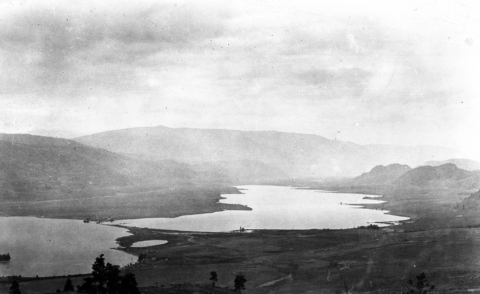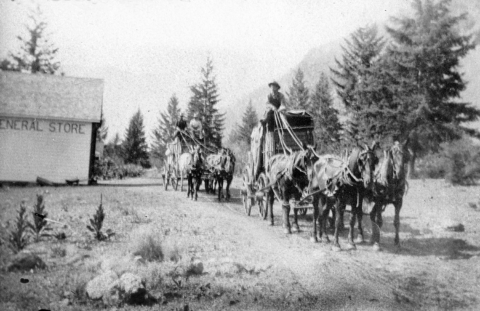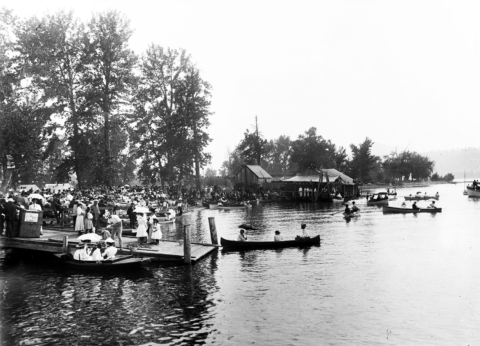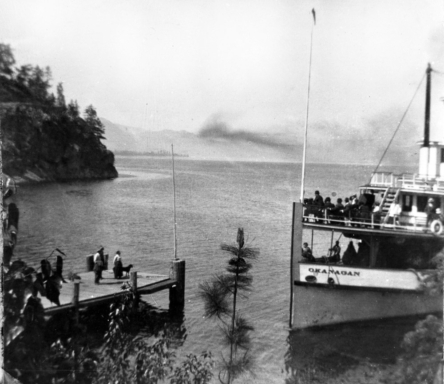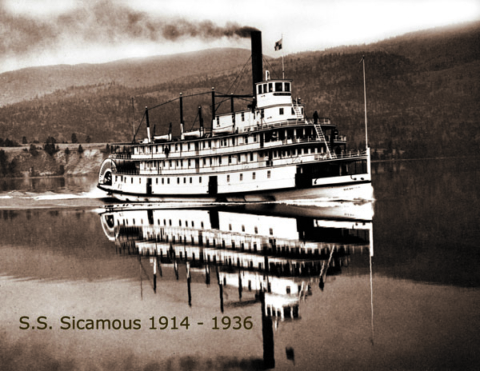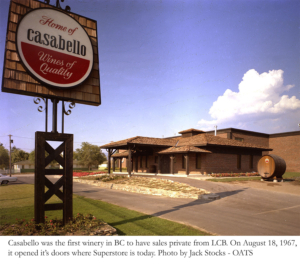
The Lougheed family were businessmen their whole lives. Sons Al and Evans grew up around their father’s grocery store on the corner of 49th and Maple in Vancouver. It did so well that the family opened “Lougheed 5 Cent to a Dollar” in the four thousand block of East Hastings Street in 1948. The postwar boom created a resurgence of investment and in 1951 they sold out to F.W. Woolworths.
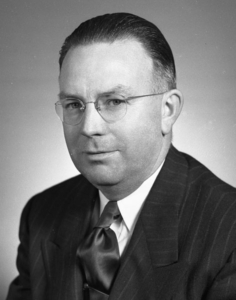
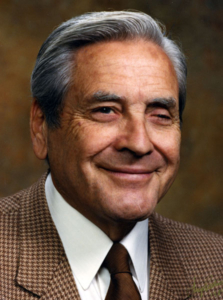 Al and Evans Lougheed
Al and Evans Lougheed
The families had vacationed in Penticton after the war and had heard many times of the lack of accommodation in the small town. Al and Evans began looking for a suitable property to build a hotel in downtown. They found that property on the corner of Nanaimo and Martin Street.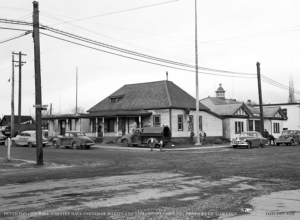 The old city building, magistrate’s office, police station and fire hall occupied 7 lots on that corner. Mayor Rathbun and his council were thrilled that a hotel could be built in the downtown core and he personally lobbied on the Lougheeds’ behalf to see them secure this property. The company offered $30,500 for the property. Seemed a little low at the time but the hotel would supply many jobs and services needed in the growing economy. As always seems to happen in Penticton, there was a tremendous outcry from some established citizens.
The old city building, magistrate’s office, police station and fire hall occupied 7 lots on that corner. Mayor Rathbun and his council were thrilled that a hotel could be built in the downtown core and he personally lobbied on the Lougheeds’ behalf to see them secure this property. The company offered $30,500 for the property. Seemed a little low at the time but the hotel would supply many jobs and services needed in the growing economy. As always seems to happen in Penticton, there was a tremendous outcry from some established citizens.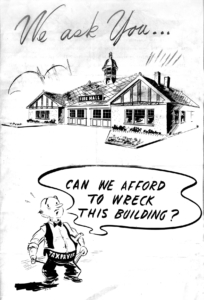
In April of 1950, Penticton citizens voted on a plebiscite to allow the sale of beer by the glass. Sounds odd today, but in the minds of the conservative community, it was a big step. Hotels were now allowed a separate beer parlour. R.J. Adams, owner of the Incola Hotel announced the construction of a separate building in December of that year. George Drossos of the Three Gables protested the proposed Lougheed hotel with ads in the Herald, letters to council and rallies with those who sided with him. It was obvious that he was threatened by the competition and used the low land offer to fan the flames.
Local media moguls, Grev Rowland and Dick Sharp, jumped to assist the Lougheed plan with supportive releases and counter ads.
The bylaw passed council unanimously just before Christmas. With solid support from Fire Chief Mervyn Foreman, council launched the demolition of the old buildings and the moving of the fire equipment to a shed on Brunswick Street. Construction of the hotel began right after New Year’s 1951.
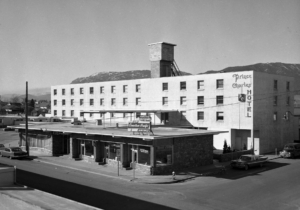
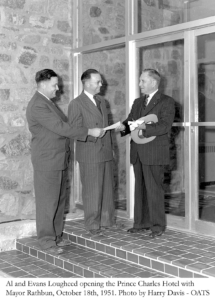
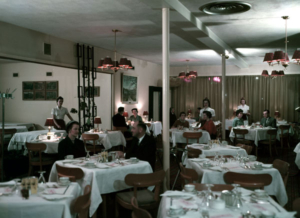
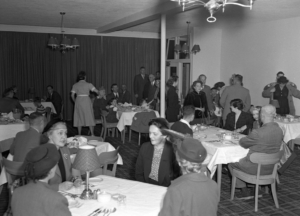
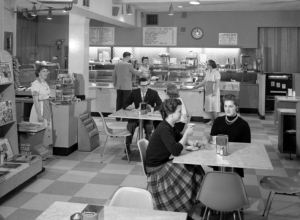
The new hotel was named The Prince Charles after the new Prince of Wales. It opened its doors to great fanfare on October 18th, 1951. The investment of over $350,000 included 52 rooms, the spacious banquet hall and the Tartan Room Restaurant. A partnership was signed with Greyhound Transportation to provide a new bus depot on the south side. Two other lots were purchased (one from Mayor Rathbun’s son) to develop the depot. The renovations included a 5 bay overhang and a large coffee shop to be open at all hours.
Other retailers leased the stores created on a strip in front of the hotel. McDonalds Gifts, Canadian Pacific Telegrams and Heather’s Ladies Apparel did business there.
The bus depot had been across the street on at least six lots and after the depot moved to the Prince Charles, the Loughheed Brothers purchased the property. In 1956, Evans discovered that Revenue Canada was looking to locate in Penticton. In meetings that year, he offered to provide a building for their offices. They agreed and the Lougheed Brothers constructed a building across from the hotel on the bus depot and Hub Billiards lots. This building not only became the Revenue Canada Centre but housed the new Toronto Dominion Bank, Sun Life Assurance Co., Law Offices, BA Oil Office, etc. for a total of 13 offices. Over the years, the retail floor held Fashion First, BCAA, and many more.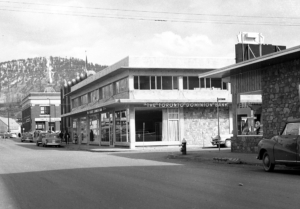 The building opened April 12th, 1957 to headlines of “Lougheed Brothers faith in city future typified in new building” and “Business services are boosted by Lougheed Block development.
The building opened April 12th, 1957 to headlines of “Lougheed Brothers faith in city future typified in new building” and “Business services are boosted by Lougheed Block development.
By 1961, The Prince Charles was the centre of community activities. Most organizations such as Kiwanis, Rotary had their meetings there. There were 67 regular employees that generated over $150,000 in wages each year. The rooms had started at $2 in 1951 and by 1961 topped room rates in town at $9.75 for a double bed with TV. Under the management of R.J. Argue, the place flourished.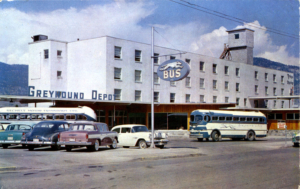 In 1964, the brothers sold the hotel and dissolved their business partnership. Al moved to Kelowna and invested in Haug Building Supply on Highway 97 near the corner of Highway 33. Evans stayed in Penticton and looked to the wine industry for a new enterprise.
In 1964, the brothers sold the hotel and dissolved their business partnership. Al moved to Kelowna and invested in Haug Building Supply on Highway 97 near the corner of Highway 33. Evans stayed in Penticton and looked to the wine industry for a new enterprise.
Evans had been impressed with the proliferation of vinifera grapes and the wine produced from them. He approached local vine grower Tony Biollo for advice on beginning a European style winery. He took Tony on as a partner and they made an offer on the Klaus orchard at the junction of South Main and Skaha Lake Road. The trees came down and the winery buildings went up. Of course, it wasn’t that simple. Evans realized there was a tremendous risk in this new agri-business. He applied for a local incentive development program from the Federal and Provincial Governments. This provided funds for the import of hybrid root stock of German and French grapes. Evans called Al and they purchased Osoyoos Vineyards to grow the stock and to process grapes already growing. On October 6th, 1966 they did their first crush. In attendance were Industry Minister Charles Drury and Provincial Agricultural Minister, Frank Richter. Casabello Wines was born.
The official opening of the wine shop was August 18th, 1967. It was the first in BC to have its own sales shop away from the LCB. Some of the innovative marketing for the winery was litre carafes and wine in a box. Casabello stoked the fire under other wine producers to design and build their own attractive wine shops to entertain tourists.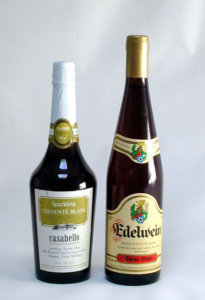
Unfortunately Al died March 24th, 1972 leaving Evans and investors to go on without him. Evans’ daughter and son-in-law were able to buy out Al’s family interest in the Osoyoos Vineyard two years later, and continued to produce the tonnage needed to supply the winery.
Evans continued with Casabello until his retirement in 1982, but he wasn’t done yet. He helped start Canwood Furniture Factory the same year. He just had a sense of obligation to provide jobs to those willing to work at something interesting.
Evans lived long enough to see his Casabello Wine building come down to make way for the new Zellers store in 1994. He died of Cancer December 14th at age 80.
His legacy remained on the mall sign as “Lougheed Centre” until the arrival of Superstore when the name mysteriously was deleted.
Thank you Stephanie Welsman for supplying the “Lougheed Scrapbook”, created by her mother, for my research.
Photography: Hugo Redivo, Harry Davis, Ed Aldredge

